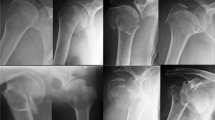Abstract
Treating proximal humeral fractures surgically has always been a challenge for the orthopaedic trauma surgeon. The challenge was and is due to numerous factors such as the specific anatomy of the proximal humerus, problems of an adequate approach and exposure of the fracture and different fracture fragments, possible iatrogenic injuries to the rotator cuff on approach and the detrimental effects of the former on the latter’s gliding and contracting ability after surgery. Furthermore, the very different fracture patterns that can occur at the proximal humerus, the shear number of fragments which can be of extremely bad bone quality, the necessity for anatomic reduction of these fragments with an implant that will allow for a stable osteosynthesis and at the meantime will not impinge in the subacromial area and lastly, the intention of the physician-in-charge to commence with physical therapy as soon as possible post OP. All of these added to the fact that not one fixation technique with one certain implant could be recommended as a treatment or implant of choice in dealing with these difficult fractures. Most of the supposedly applicable surgical techniques and implants had major setbacks such as being limited to only very expert hands, necessitating a long-standing postoperative immobilisation, resulting in secondary loosening of implants, secondary loosening of reduction or impaired bone healing and, despite all efforts, finally led to poor function at the shoulder. With the advent of angular stable implants such as angular stable, anatomically contoured plates designed for proximal humeral fractures only and special angular stable nails for the same or similar indications the treatment options and the quality of treatment in this area was much improved. Our experience with angular stable nails of two different manufacturers in now more than 320 implantations reveals that indications for the surgical treatment of such fractures can be extended constantly, that the number of complications will simultaneously decline, the necessity for primary joint arthroplasty even in multiple fragment fractures is minimal and that long-term results are, comparing the published results in the literature with those of our institution, equal if not superior to other treatment options.
Similar content being viewed by others
Author information
Authors and Affiliations
Corresponding author
Rights and permissions
About this article
Cite this article
Rueger, J.M., Rücker, A., Briem, D. et al. Proximal Humeral Fractures: Nailing. Eur J Trauma Emerg Surg 33, 357–366 (2007). https://doi.org/10.1007/s00068-007-7098-1
Received:
Accepted:
Published:
Issue Date:
DOI: https://doi.org/10.1007/s00068-007-7098-1




